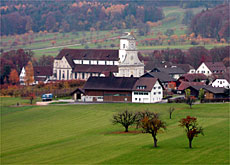
Mariastein monastery unites the faithful

Religious faith unites people from different countries and cultures and the best proof of that is the popularity of the Mariastein monastery.
Located in Switzerland’s northwest corner, Mariastein is a place of pilgrimage attracting 150,000 people a year from far and wide.
People have been flocking to Mariastein for about 600 years to worship at an image of the Virgin Mary in a chapel cave in the monastery confines.
According to legend, a boy who fell down the cliff from the cave entrance was miraculously saved by the Virgin Mary.
“People come from Switzerland, they come from Alsace in France and from Germany’s Black Forest region,” explains Father Armin Russi, during a tour.
“We are here where the three countries come together and I think in this area the borders are more connecting then separating.”
Tamil pilgrims
“We also have a lot of people from Switzerland’s large community of Tamils,” he adds. “They are not Christians but this place must be a place of peace, where they find comfort, where they find new hope and strength for their lives.
I think that is as miraculous as if someone had been saved from a fall.”
It could also be considered a miracle that Mariastein is still a working monastery.
The monks were banished by the authorities of Solothurn in the latter half of the 19th century during the religious struggle, and only returned about 30 years ago.
They moved to France, eventually made their way to Austria where they were forced to flee again by the Nazis, and ironically returned to Mariastein to seek asylum in their own monastery.
In typical Swiss fashion, voters in Solothurn decided to restore the legality of the monastery in 1971.
The monks set about restoring the buildings and the work was finally completed in 2000.
Miraculous image
A long whitewashed corridor leads slowly down to a staircase, which takes pilgrims into the chapel cave displaying the “miraculous image”.
The image is a stone statue of a seated Mary, holding the Christ child. Because of the expression on her face she has become known as the smiling Madonna.
The church above, built in the middle of the 17th century in Gothic style, has undergone several changes.
It was repainted in a neo-Baroque style in the first half of the last century. The final work restored the bright colours from this period.
The main pictures on the ceiling depict the miracle rescue of the boy, and the reunification of the boy and his mother.
The impressive 18th century pulpit is carved from wood in the Baroque style. The centrepiece of the choir is the high alter made in 1680, donated by King Louis XIV.
The large organ with 39 registers is less than 30 years old but it was built using the old organ case.
“I’m guest master and also responsible for the music,” says Father Armin as he sits down to play.
swissinfo, Dale Bechtel in Mariastein

In compliance with the JTI standards
More: SWI swissinfo.ch certified by the Journalism Trust Initiative


























You can find an overview of ongoing debates with our journalists here . Please join us!
If you want to start a conversation about a topic raised in this article or want to report factual errors, email us at english@swissinfo.ch.